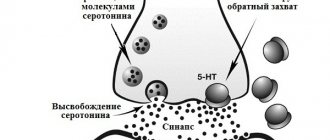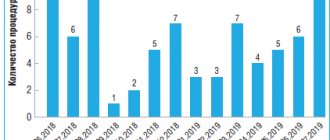Turn back the clock: new frontiers in the treatment of multiple sclerosis
– Multiple sclerosis is a fairly common neurological disease throughout the world. What is the situation in Russia?
– I wouldn’t say that we are somehow different from the rest of the world; we have approximately the same age range of patients. In terms of incidence, we belong to a medium-risk zone, we have from 10 to 50 cases per 100 thousand population, but in different regions the situation is slightly different. Official current statistics, unfortunately, are known only to the Ministry of Health of the Russian Federation, but at a recent meeting of the Federation Council, representatives of the department reported that we already have more than 85 thousand patients in the federal register. Although the medical community assumes that there should be more than 100 thousand patients.
– How is the profile patient audience classified?
– It is customary to distinguish three types of multiple sclerosis: relapsing-remitting, secondary progressive and primary progressive. In 70–85% of patients, the disease debuts with a relapsing course, which subsequently becomes secondary progressive. Approximately 10–15% are patients with a primary progressive course. There are no official statistics on the primary progressive course in Russia yet, because there was no targeted therapy for these patients until 2021. Therefore, as a rule, their share turned out to be underestimated, somewhere between 2–5% of those officially observed. Now, since targeted therapy has appeared, the approach to both register maintenance and diagnosis has changed. We are striving for earlier diagnosis and greater consideration of these patients, because now there are solutions that we can offer them as therapy. Accordingly, we will gradually get closer to identifying 10% of patients with the primary progressive form and will approximately reflect this group statistically. If we take all patients divided by lobe, it is difficult to say unambiguously, but probably about 70% will be relapsing-remitting, 20% secondary-progressive and about 10% primary-progressive patients.
– What are the scenarios for the development of the disease?
– Patients with a remitting course have the most favorable scenario, because their disease progresses with exacerbations and remissions. Accordingly, during an exacerbation, some new symptoms appear. Some or all of them may regress or may leave behind neurological deficits. But during the period of remission, it is considered that the patient’s condition is stable, that is, there is no increase in symptoms or increase in disability. If the frequency of exacerbations is high or they generally persist, then, of course, this patient may at some point acquire signs of disability. In the secondary progressive type, which replaces the remitting phase of the disease, the disease does not progress from the very beginning. This is precisely the patient who initially had an undulating course of the disease, and then began to show signs of a steady increase in neurological deficit and, accordingly, worsening disability. At the same time, he may continue to have exacerbations, but progression does not depend on them. In some patients, exacerbations at this stage of the disease are no longer observed and only an increase in disability is observed. With the primary progressive type, it is believed that immediately, from the very onset, there is a steady increase in neurological deficit. That is, the symptoms do not regress, but only new manifestations of the disease appear.
– What are the current approaches to treating patients with relapsing-remitting multiple sclerosis?
– Therapeutic approaches remain unchanged. We have pathogenetic therapy, and there is symptomatic therapy. Pathogenetic includes hormonal therapy for exacerbations and immunomodulatory therapy aimed at preventing exacerbations, delaying the progression and increase of changes in brain tissue. For patients with relapsing-remitting multiple sclerosis, the range of drugs is the widest. Almost every year a new drug is released that adds treatment options. Tactically, among all patients with a relapsing course, patients with a rapidly progressing scenario and with highly active multiple sclerosis began to be distinguished. These are those patients in whom either each exacerbation leaves a neurological deficit, and thus the patient’s condition worsens with each new exacerbation, or those who, in principle, during the year, despite receiving any therapy, experience two or more exacerbations, that is It is difficult to keep them simply in a state of remission. When monitoring such patients, a more aggressive strategy is used: either early escalation of therapy - they are transferred from the first line to the second, or the doctor immediately has the right to begin treatment with second-line drugs.
– At what point are patients with multiple sclerosis prescribed drug therapy?
– In general, world practice, as well as Russian practice, is as follows: as soon as a patient is diagnosed with multiple sclerosis, doctors focus on early initiation of therapy. In our country, after a diagnosis is established, personalized information about the patient is entered into the federal register of the Ministry of Health of the Russian Federation, and the patient acquires the right to receive drug therapy free of charge. Another thing is that not all patients agree to treatment that lasts for years; some prefer to be monitored before starting to take medications. In any case, we try to select the optimal treatment option for everyone.
– How then is the effectiveness of the prescribed drug determined?
– Three criteria are used here: firstly, clinical observation – exacerbations persist or are absent; secondly, a neurological examination with assessment of the condition according to the international disability scale EDSS - whether or not there is an increase in neurological deficit; and thirdly, dynamic MRI of the brain/spinal cord allows one to assess the activity of the process in the form of the appearance of new foci or contrasting foci.
– Given the emergence of new drugs, do doctors’ expectations of therapy change?
– Of course, we want, in addition to influencing quantitative changes in brain tissue, to also have the opportunity to inhibit brain atrophy, the rate of which in our patients is higher than age-related physiological atrophy. This is one of the new requirements. And the second is the ability to influence neurodegeneration. In other words, it would be ideal if it were possible to reduce persistent neurological deficits and reverse the process. But so far there are no drugs that can meet these expectations.
– Do you work with the drug alemtuzumab (Lemtrada ® ) and how do you evaluate the practice of its use?
– I have extensive experience in using this drug, I am familiar with it from the development stage and have been observing patients on therapy since 2003 as part of clinical trials. I have quite good impressions, although I can immediately say that alemtuzumab is a complex drug, so it is not indicated for all patients in terms of safety profile.
In the most recent clinical trial of the drug, nine years of data are now available, 49% of patients in the CARE-MS II clinical trial experienced improvement and maintained it over that time. The maximum follow-up period for my patients treated with alemtuzumab was 15 years, but that study has now been completed and the drug has already been registered. Despite this, the developer continues to collect data regarding both the effectiveness and safety profile during phase III clinical trials. Alemtuzumab therapy differs from other immunomodulatory drugs in its cyclic dosing regimen. The first treatment course of therapy consists of two treatment cycles with an interval of a year. There are some patients in my cohort who, after receiving these two treatment cycles, no longer required re-introduction of the drug throughout the study follow-up period. And there are patients who, in some cases three years later, in others five or six years later, still had a “surge” in disease activity. They carried out another treatment cycle and thanks to this maintenance cycle they were able to keep the patient in a stable condition. Therefore, it cannot be said that 100% of patients were stable based on the results of the first starting cycle. But according to clinical studies conducted by the developer, approximately 55% of those observed did not really need to re-administer the drug and at the same time maintained a stable condition. That is, they received two treatment cycles and then everything was fine.
– For what group of patients is the drug recommended?
– Now the drug has updated instructions, which clearly define the patient profile. These are patients with ongoing disease activity on the background of first-line immunomodulatory therapy (highly active disease) or patients with rapidly progressive multiple sclerosis, who, as I have already said, have two or more exacerbations leading to an increase in neurological deficit. Such patients, in principle, according to world statistics, constitute 15–20% of all patients with the remitting type of the disease. This is the target patient population for this type of therapy.
– One of the new criteria for the effectiveness of the drug is confirmed reduction in disability (CDI). What current data does the medical community have on this indicator?
– Naturally, we doctors dream of reducing disability. Data from studies of alemtuzumab suggest that such a result is possible. But we must understand that this effect of reducing disability is not achievable in all patients. It is probably possible to obtain this result, and it will be lasting, if the patient’s profile is correctly determined and, most importantly, therapy is started in a timely manner. Turning back the clock is probably possible if therapy is started in the first three to five years from the onset of the disease.
– When and how is a confirmed reduction in disability assessed?
– Assessment is carried out using the Expanded Disability Scale EDSS. The level of disability corresponds to a certain score, which can increase or decrease. The higher the score, the greater the patient's level of disability. After a neurological examination, the doctor can assess the level of EDSS and note whether there is an increase in it, which tells us about the progression of the disease, or a decrease, indicating an improvement in the patient’s condition. Imagine you have some symptoms, and then their severity decreased, or they regressed, they are gone.
– The drug Lemtrada ® (INN alemtuzumab) was included in the list of 14 high-cost nosologies in 2021, how is this decision assessed by the medical community?
- Of course, it’s positive. This makes it possible to provide the drug to as many patients as this therapy is indicated for. Each subject of the Russian Federation determines the need for the drug itself. Previously, the availability of this therapy was limited by the financial capabilities of the subject; now these drugs are centrally purchased by the Ministry of Health.
The material was prepared with the support of the representative office of Sanofi-Aventis Group JSC (France)
MAT-RU-2001393
Risk of coronavirus infection and multiple sclerosis
Some evidence suggests that multiple sclerosis (MS), like other autoimmune diseases, can be triggered by a variety of infectious diseases [16]. Research also suggests that certain infections, particularly respiratory tract infections, may be associated with exacerbation of MS. Experts note that the theory of the infectious origin of MS has certain shortcomings, but bacteria and viruses can indeed influence the immune response of our body [16].
The British organization Multiple Sclerosis Trust notes that the risk of developing COVID-19 in patients with MS is the same as in any other people [9]. That is, there is currently no evidence that there is any additional risk of infection. Most people with MS should follow the recommendations of health organizations and governments, which can be found on a Russian website with up-to-date information about the new coronavirus [17]. Social isolation in this case is the easiest way to protect yourself.
New multiple sclerosis drug Vumerity is more effective than previous ones
The US Food and Drug Administration has approved Vumerity™ (diroxymel fumarate, Biogen and Alkermes plc) as a new treatment for people with relapsing forms of MS.
Relapsing forms of MS include people with clinically isolated syndrome (an initial episode of neurological symptoms), relapsing-remitting MS, and active secondary progressive MS.
Vumerity is similar to dimethyl fumarate (Tecfidera, ® Biogen) but has a different chemical structure that has been shown to have fewer reported gastrointestinal side effects than Tecfidera.
Once in the body, Vumerity quickly turns into the same active ingredient as Tecfidera. Due to the bioequivalence of Tecfidera, it was not necessary for Vumerity to undergo extensive clinical trials to demonstrate its benefits for the treatment of relapsing MS.
Although their exact mechanisms of action are unknown, Vumerity and Tecfidera are thought to reduce immune response activity and have antioxidant properties. These mechanisms help protect the brain and spinal cord from damage.
Potential Benefits : Biogen Inc. and Alkermes plc announced the best results from a five-week Phase III study comparing the gastrointestinal side effects and tolerability of Vumerity and Tecfidera. According to the press release, diroxymel fumarate was better tolerated and had significantly fewer gastrointestinal symptoms compared with Tecfidera.
The most common adverse events for both treatment groups were hot flashes, diarrhea, and nausea. The incidence of these events was significantly lower in the dioxymel fumarate group, and fewer people taking dioxymel fumarate dropped out of the study due to side effects.
Potential Risks : Like Tecfidera, Vumerity may cause serious side effects, including: an allergic reaction (such as hives); PML (progressive multifocal leukoencephalopathy, a rare brain infection that can cause death or severe disability within weeks or months); decreased white blood cell count and liver problems.
According to nationalmssociety.org, taking disease-modifying therapy is currently the best way to reduce the activity of multiple sclerosis.
The choice of MS treatment should be made by patients in collaboration with their physician. Many factors must be taken into account, including the effectiveness of current therapy, weighing potential risks and benefits, costs and lifestyle impacts.
What happens if you don't get rid of multiple sclerosis? Consequences of the disease
With benign development, the disease progresses quite slowly. For 10–15 years, a person may not feel significant changes or disruptions in the body’s functioning. But if you do not get rid of the malignant form of multiple sclerosis, which occurs in approximately 15% of cases, then it develops very rapidly. In just 2-3 years it can chain a person to a wheelchair. The course of multiple sclerosis in a particular patient is unpredictable, so it is necessary to constantly be under the supervision of a specialist.
If no action is taken, the disease continues to develop at a lower or greater speed, causing more and more problems for the person. The most common type of MS is relapsing-remitting (up to 90% of cases). It alternates between periods of weakening (remission) and exacerbation (relapse) of the disease. After a relapse, the functions of the affected organs are restored partially, completely or not at all.
How does multiple sclerosis manifest?
Multiple sclerosis is often called “the disease with a thousand faces” because its symptoms are not specific and can come and go.
“This is weakness in the limbs, especially worse after taking a hot bath or sauna, sudden attacks of incoordination without dizziness, recurrent visual impairment...,” lists Yan Vlasov. “All these symptoms are like a touch, they can even change during the day, they should alert a neurologist - this is where multiple sclerosis begins.”
It is a big mistake on the part of patients and their environment not to take these symptoms seriously and postpone a visit to a neurologist. If the doctor doubts the diagnosis, he can refer the patient to a center for help with multiple sclerosis. Information on regions can be found on the website of the All-Russian Public Organization of Disabled Persons with Multiple Sclerosis.
The hospital can diagnose multiple sclerosis within a maximum of three months - and this is a big step forward, because until recently the diagnosis took several years. But this level of medicine is available only in large cities; in rural settlements and small towns there are often no specialized specialists and the necessary equipment.
For almost twenty years, the Russian Committee of Multiple Sclerosis Researchers has been traveling to different regions and holding two-day schools there on all aspects of the treatment and diagnosis of multiple sclerosis. Thanks to this, there have been fewer cases where a sick person from a small town found out his diagnosis only a year or three after the first manifestation.
“We really hope that in the next six years they will create a system for standardizing specialized medical care specifically for patients with multiple sclerosis,” says Yan Vlasov. — If we create a standardization system, create first-, second-, third-level medical institutions that deal with this problem, we will be able to easily cover rural areas, and yet two-thirds of our citizens live there. [Currently] the number of part-time jobs there is very high, the equipment available is low, and to the nearest populated area where there is - I’m not talking about a tomograph, at least a specialized specialist! - 500 kilometers each.”







